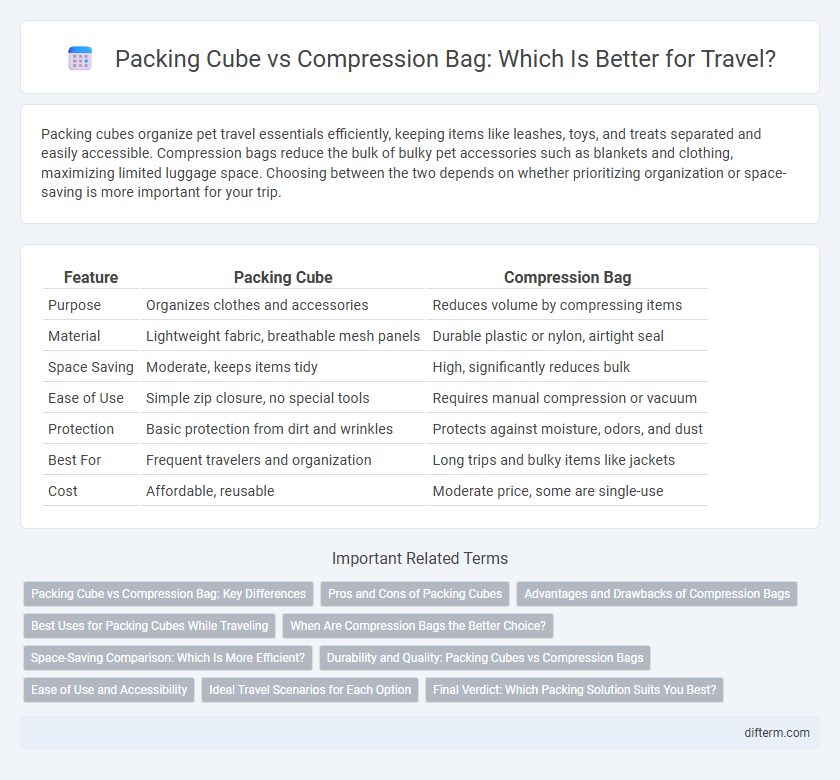Packing cubes organize pet travel essentials efficiently, keeping items like leashes, toys, and treats separated and easily accessible. Compression bags reduce the bulk of bulky pet accessories such as blankets and clothing, maximizing limited luggage space. Choosing between the two depends on whether prioritizing organization or space-saving is more important for your trip.
Table of Comparison
| Feature | Packing Cube | Compression Bag |
|---|---|---|
| Purpose | Organizes clothes and accessories | Reduces volume by compressing items |
| Material | Lightweight fabric, breathable mesh panels | Durable plastic or nylon, airtight seal |
| Space Saving | Moderate, keeps items tidy | High, significantly reduces bulk |
| Ease of Use | Simple zip closure, no special tools | Requires manual compression or vacuum |
| Protection | Basic protection from dirt and wrinkles | Protects against moisture, odors, and dust |
| Best For | Frequent travelers and organization | Long trips and bulky items like jackets |
| Cost | Affordable, reusable | Moderate price, some are single-use |
Packing Cube vs Compression Bag: Key Differences
Packing cubes organize clothing efficiently by compartmentalizing items, making it easy to access specific garments without unpacking everything. Compression bags reduce volume by removing air, allowing more space in luggage but requiring repacking to reach items. While packing cubes prioritize organization and quick access, compression bags maximize packing space at the cost of convenience.
Pros and Cons of Packing Cubes
Packing cubes offer superior organization by separating clothing and accessories into neat compartments, making it easier to locate items quickly during travel. They maintain fabric shape and reduce wrinkles compared to compression bags, which may overly compress delicate garments. However, packing cubes do not reduce volume as effectively as compression bags, resulting in slightly more luggage space required.
Advantages and Drawbacks of Compression Bags
Compression bags maximize luggage space by significantly reducing the volume of clothes through vacuum-sealed air removal, making them ideal for extended trips or bulky items like jackets. They protect contents from moisture, dust, and odors, but require access to a vacuum or manual pump, which can be inconvenient during travel. The drawback includes potential fabric wrinkles from compression and limited flexibility in adjusting bag sizes once sealed.
Best Uses for Packing Cubes While Traveling
Packing cubes are ideal for organizing clothing and accessories by category, making it easier to find items quickly during travel. They maximize suitcase space without compressing clothes, maintaining garment shape and reducing wrinkles. Best suited for frequent travelers seeking convenience and efficient organization, packing cubes enable easy repacking and compartmentalization within carry-ons or checked luggage.
When Are Compression Bags the Better Choice?
Compression bags are the better choice for travelers needing to maximize space when packing bulky clothing like sweaters, jackets, or blankets, as they significantly reduce volume by expelling air. These bags also protect items from moisture and dirt, ideal for outdoor adventures or long-term storage. Unlike packing cubes, compression bags are less accessible for quick organization but excel in space-saving efficiency for extended trips.
Space-Saving Comparison: Which Is More Efficient?
Packing cubes offer organized compartmentalization, making it easier to access items without unpacking entirely but provide moderate space-saving benefits. Compression bags significantly reduce volume by removing excess air, making them more efficient for maximizing suitcase capacity during extended travel. However, compression bags require careful handling to avoid wrinkles and may not provide the same level of organization as packing cubes.
Durability and Quality: Packing Cubes vs Compression Bags
Packing cubes are crafted from high-quality nylon or polyester with reinforced stitching, offering superior durability and resistance to wear during frequent travel. Compression bags, often made from thinner plastic materials, provide effective space-saving benefits but may be prone to punctures and reduced lifespan over time. The choice between the two depends on prioritizing long-term durability and reliable protection (packing cubes) versus maximum compression with potential trade-offs in material quality.
Ease of Use and Accessibility
Packing cubes offer superior ease of use by allowing travelers to organize items in separate compartments, making access quick and hassle-free during packing and unpacking. Compression bags save space by reducing volume but often require more effort to seal and access, which may complicate retrieval of specific items. Choosing packing cubes enhances accessibility with simple zipper access, while compression bags prioritize compactness at the cost of convenience.
Ideal Travel Scenarios for Each Option
Packing cubes are ideal for organized travelers who prefer compartmentalized storage and easy access to belongings during city tours or short trips. Compression bags suit backpackers and long-term travelers needing to maximize space by reducing bulk, especially for bulky items like jackets or sweaters. Each option enhances packing efficiency, with cubes favoring tidiness and compression bags optimizing volume reduction for extended journeys.
Final Verdict: Which Packing Solution Suits You Best?
Packing cubes offer organized compartments that keep clothes neatly separated and easy to find, enhancing accessibility during travel. Compression bags reduce volume by compacting soft items, ideal for maximizing suitcase space but may require more effort to access specific items quickly. Choose packing cubes for efficient organization and quick access, or compression bags if you prioritize saving space and packing more into limited luggage capacity.
packing cube vs compression bag Infographic

 difterm.com
difterm.com